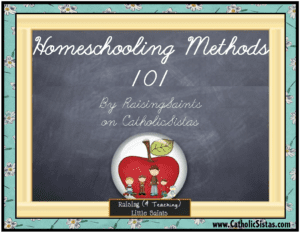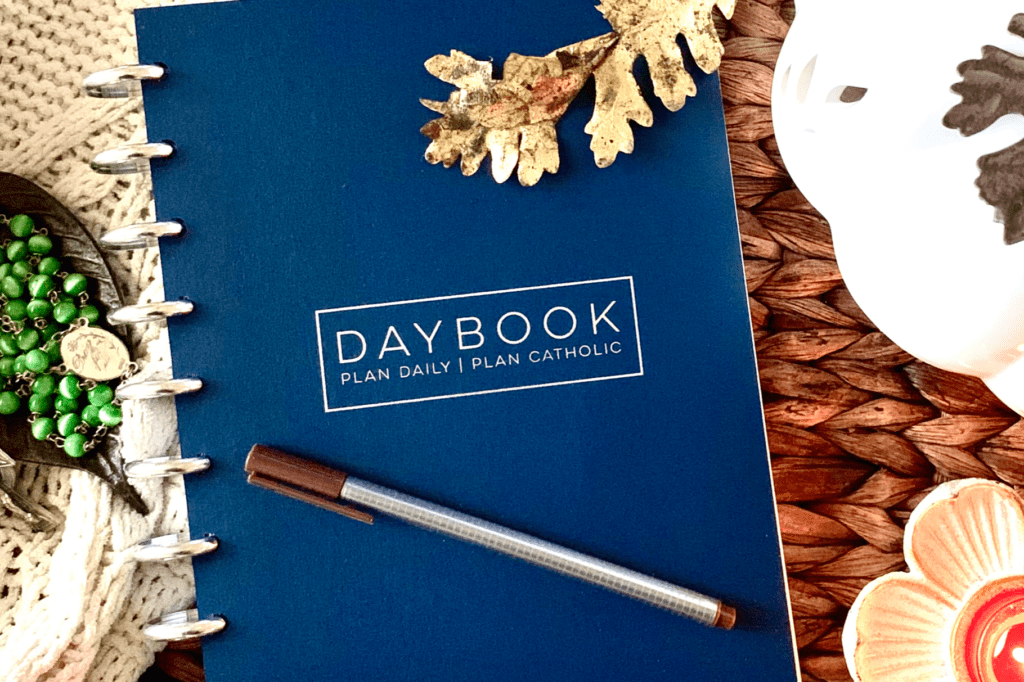 If you have been following our series, I first wrote about the 10 Steps to Start Catholic Homeschooling and then on Goal Setting in the Catholic Homeschool, now we are going to discuss the different homeschooling methods available to you. So you’ve decided to Homeschool, you looked up the laws in your state, you contacted the local organization and even want to join a homeschool co-op. Now what? Well, now you need to decide what method you will use in your homeschool. First, I would like you to learn a little bit about yourself as a teacher and a former student.
If you have been following our series, I first wrote about the 10 Steps to Start Catholic Homeschooling and then on Goal Setting in the Catholic Homeschool, now we are going to discuss the different homeschooling methods available to you. So you’ve decided to Homeschool, you looked up the laws in your state, you contacted the local organization and even want to join a homeschool co-op. Now what? Well, now you need to decide what method you will use in your homeschool. First, I would like you to learn a little bit about yourself as a teacher and a former student.
As you read through these available methods, please keep in mind four things:
1. TEACHING STYLE: Your preferred teaching style, which you may or may not be aware of yet.
2. LEARNING STYLE: Your child’s learning style. We will discuss this in more detail later but basically, this refers to how your child learns best. For example, some children are auditory learners as they capture things easily by just listening to a lecture. Other children are visual learners and need to read along, highlight, and follow. It is important as your child’s teacher to find their learning method. Which you will use often but not exclusively.
3. WHEN ALL ELSE FAILS: There is always the eclectic approach which is a hodgepodge of all methods.
4. FLEXIBILITY. Be flexible. You might begin using one method and later realize you need to shift gears.
Next, I’d like to explore all the methods available:
1. Textbook-Based/Traditional Schooling Method: this is the method most of us were taught in traditional classroom settings using textbooks.
This method works well under the following conditions:
- want your child to be studying material in a similar scope and sequence as other public or private schools,
- value the style of a classroom school and want your child to experience that at home,
- want your child to be able to do well and learn through fill-in-the-blanks and quizzes,
- have definite ideas about what content you want your child to learn, and it matches well with the textbook you have chosen.
2. Classical Homeschooling Method: This method depends on a three-part process of training the mind. The early years of school are spent in absorbing facts, systematically laying the foundations for advanced study. In the middle grades, students learn to think through arguments. In the high school years, they learn to express themselves. This classical pattern is called the trivium.
This method works well under the following conditions:
- like structure,
- desire to evaluate your childs learning based on academic standards,
- see the value of an education that places primacy on the written word, both in reading and writing well,
- believe that developing good study skills fairly early on in your child’s life will benefit him greatly as time goes on,
- want to concentrate on classics of literature as a tool to develop critical thinking,
- do not mind being fairly involved in the process of your childs education discussing books, giving dictation, encouraging the reaching of academic goals,
- have a child who is academically oriented.
3. Charlotte Mason (CM )/Living Books Homeschooling Method: A method of education in which children are taught as whole persons through a wide range of interesting living books, firsthand experiences, and good habits.
This method works well under the following conditions:
- want to create a learning environment that encourages your child to explore and appreciate the world around him, perhaps not rigidly sticking to a schedule,
- see a value in evaluating your childs learning on things other than formal written tests,
- want to offer a well-rounded education, including enjoying art, nature, music and of course lots of books,
- dont mind being very involved in the process of your childs education discussing books, giving dictation, listening and encouraging narration, and enjoying poetry, art and music together,
- have a child who is does not mind not having lots of boxes to check off.
4. Montessori Method: This method is best described as an “Aid to Life” rather than a specific method of passing on academic objectives. It prepares students to succeed in a world where technology is changing the way we live at a very rapid pace, and general life skills are far more valuable than mastery of an outdated academic curriculum.
This method works well under the following conditions:
- want your children of different ages all studying similar subjects at their own level,
- have enough time to interact with your children about the materials they are studying and how they relate,
- see a value in taking the time to do hands-on-projects and group learning around a central theme,
- or your child dont not following a traditional scope and sequence.
5. Unit Study Method/Notebooking Method: Unit Studies, which typically tie in closely with Lapbooking or Notebooking. Basically, it takes a central theme and builds lessons around that theme. One theme will include all or most areas of study by focusing on the main idea.
This method works well under the following conditions:
- want your child to have the freedom to follow her own interests,
- have enough confidence in the process of learning that you dont mind if not all of your childs learning can be documented by a written test (see Unschooling),
- see a value in having your child develop expertise in an interest, and are willing to let other activities take second place, at least for a season,
- have a child who has interests, hobbies or collections they want to pursue,
- you want to document their learning by a written record of a notebook,
- your child is willing to learn to let his creativity out in his learning. Note: he doesnt necessarily have to start off with skill, but at least willing to learn.
6. Unschooling/Relaxed Homeschool Method: allowing children as much freedom to learn in the world, as their parents can comfortably bear. The advantage of this method is that it doesn’t require you, the parent, to become someone else, such as a professional teacher pouring knowledge into child-vessels on a planned basis. Instead you live and learn together, pursuing questions and interests as they arise and using conventional schooling on an on-demand basis, if at all. This is the way we learn before going to school and the way we learn when we leave school and enter the world of work.
This method works well under the following conditions:
- dont mind not having a set scope and sequence and structure to your childs learning,
- want your child to have the freedom to follow her own interests,
- have enough confidence in the process of learning that you dont mind if not all of your childs learning can be documented by a written test,
- see a value in having your child develop expertise in an interest, and are willing to let other activities take second place, at least for a season,
- have a child who has interests, hobbies or collections they want to pursue.
7. Computer Based Homeschooling Method this method is exactly what you read, learning done via the computer either locally or online
This method works well under the following conditions:
- want to have your child follow a set scope and sequence,
- want to have step-by-step accountability for your child,
- see a value in using modern technology and dont have concerns for its over-use,
- need to find a way to not be involved so much in the day-to-day process of your childs education, though you would be available to give help and general guidance,
- have a child who likes being able to work at his own pace and use the computer.
8. Literature-Based Homeschooling Method this method uses literature as the core of the curriculum and pulls from the book to incorporate other subjects.
This method works well under the following conditions:
- want to have your child follow a set scope and sequence,
- want to have general accountability for your child,
- see a value in having your child love to read by reading books he or she will love to read,
- want to be involved in the day-to-day process of your childs education, through discussion that will draw out what your child is learning and perhaps controversial issues raised through the books.
9. Eclectic Homeschooling Method this is the combination approach.
This method works well under the following conditions:
- dont mind spending the time to find the materials that will suit your childs unique interests and learning styles,
- dont mind not following someone elses scope and sequence, and thus not mind the possible gaps in their learning that might come from jumping around from one curriculum to another,
- see the value in using various curriculum and home school methods because through different methods, your child gets a more full picture of the subject at hand,
- have a child who likes flexibility in her learning, who does not mind not using the same materials over again.
No matter the method you select make sure it is one you are comfortable working with or at least feel brave enough to attempt. Another thing to keep in mind is the type of Mass you attend and the theology program you select, this will help come Sundays at Mass.
Stay with us as we explore other factors in Catholic Homeschooling 101 next Saturday.

